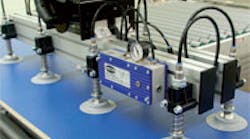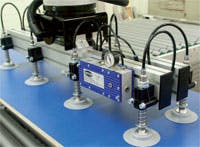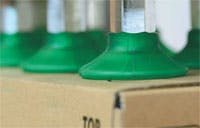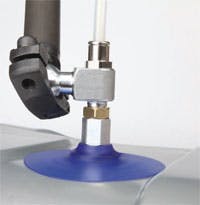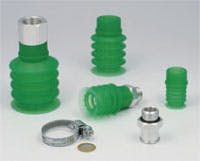Many details come into play when designing a vacuum handling system. On one hand, designers must contend with the size, weight, and type of material to be handled, and how fast and precisely it must be moved. On the other, there’s the size and type of vacuum generator, system operating pressure, components — such as valves, hoses, and connectors — as well as up-front and operating costs. (For more information on complete system design, see “Getting a grip on vacuum-handling systems,” Hydraulics & Pneumatics, May, 2010)
But a key component in any vacuum handling system is the vacuum cup or pad. This seemingly simple device must firmly and safely support the load, resist gravitational and acceleration forces, minimize air consumption, and not mar or damage the workpiece. And, of course, it must resist fatigue and abrasion, withstand dirt, contaminants, temperature extremes, and provide long, economical life with little or no maintenance.
Basic considerations
Obviously, a lot should go into selecting a suction pad. Leading manufacturers offer extensive data on various types of pads and the advantages of each, along with load capacity, temperature limits, chemical compatibility, and so on. Designers should select vacuum pads based on the following criteria:
Operating conditions — Cycle rates, expected life, aggressive surroundings, temperature, and other environmental factors are all considerations when selecting vacuum pads.
Material — Vacuum pads come in a wide range of materials to meet specific application requirements. Common materials include nitrile, silicone, natural rubbers, fluoroelastomers, and polyurethanes. Some materials are particularly suited to smooth, rough, or oily surfaces, or easily damaged workpieces. Special antistatic vacuum pads are designed to handle electronic components, while others won’t leave marks on plastic parts. Environmental conditions can affect the material choice when the pads must resist ozone, chemicals, extreme temperatures, or be silicone-free.
Surface — The workpiece surface may make certain types of vacuum pads more suitable than others. The wide range of available products includes flat and bellows suction pads in many sizes and shapes with various types of sealing lips and sealing edges.
Selection factors
Designers should determine certain physical parameters as part of the selection process.
Coefficient of friction — It is usually not wise to assign a ballpark value for the coefficient of friction, μ, between the suction pad and workpiece. This means designers must determine μ beforehand through testing. However, as a general guide, approximate values for various workpiece surfaces include:
- oily surfaces: μ = 0.1,
- moist, wet surfaces: μ = 0.2 to 0.4,
- glass, stone, plastic (dry), wood, and metal: μ = 0.5,
- rough surfaces: μ = 0.6, and
- sand paper (dry): μ = 1.1.
Holding forces — Many factors, such as the size and shape of the vacuum pad, its surface finish, plus rigidity (deformation) of the workpiece, are important when calculating holding forces. For this reason, we recommend that engineers include a safety factor of at least two. German accident-prevention regulations demand a minimum safety factor of 1.5. Operations that swivel or turn over the workpiece use a safety factor of 2.5 or higher to cope with the resulting forces.
Vacuum pad diameter — Absolute holding force depends on the vacuum pad diameter and the workpiece surface finish. Determine the required diameter with the following equations.
For forces applied horizontally:
d = 1.12 [(m S) (PU n)]½
For forces applied vertically:
d = 1.12 [(m S) (PU n μ)]½
where, d = internal diameter of the sealing lip, cm, m = mass of the workpiece, kg, PU = vacuum, bar, n = number of suction pads, S = safety factor, and μ = coefficient of friction.
Vacuum capacity — The level of vacuum required and circuit volume are critical for calculating the necessary vacuum capacity. However, keep in mind that the workpiece material is the decisive factor that determines vacuum capacity. For porous parts, always carry out vacuum tests to ascertain actual capacity requirements.
Additional factors — In addition to the factors mentioned here, vacuum system manufacturers often list other data for individual vacuum pads to aid in the selection process. For example, data for Schmalz suction pads include:
- Theoretical suction force of a vacuum pad is calculated from the pressure differential and the surface area: F = ΔpA. Schmaltz bases this value on a –0.6 bar vacuum (at sea level) with a smooth, dry workpiece surface. Depending on operating conditions, this value may have to be reduced to account for the safety factor, friction losses, or a lower vacuum level — for example, due to a porous workpiece.
- Internal volume is used when calculating the total volume of the gripper system and, thus, total evacuation time and equipment cycle rate.
- Minimum radius of curvature specifies the minimum radius that a suction pad can securely grip, which is important for curved workpieces.
- Vacuum pad stroke is the lifting effect during evacuation of a vacuum pad. It typically applies to bellows-type pads. It also allows for height compensation and gentle cup placement.
Universal pads
Manufacturers generally classify suction pads as universal or special purpose. Universal pads cover a wide range of requirements, while specific-duty pads are designed to meet special requirements, such as handling thin automobile body parts or porous workpieces in the woodworking industry. The two most-common types of universal products are flat and bellows vacuum pads.
Flat vacuum pads are particularly suited for handling objects with flat or slightly curved surfaces. They come in a wide range of materials, sizes, and shapes, including round and oval, with steep or flat sealing lips. Low overall height and small internal volume produces short evacuation times, letting them grip workpieces quickly. The flat shape ensures good stability when attached to a load, and they withstand high lateral forces during fast movements.
Flat vacuum pads also are typically used for handling smooth or slightly rough workpieces, such as metal, glass, and wood sheets, cardboard boxes, and plastic parts. Wear-resistant versions can handle higher loads and give up to 10 times the life of standard NBR (nitrile-rubber) units. Flat, oval suction pads produce high forces despite relatively small dimensions. They’re best suited for thin and curved objects, such as extrusions, pipes, and sections of door and window frames.
Bellows suction pads compensate for varying workpiece heights and can handle parts with curved or uneven surfaces or those that are easily damaged. Like flat pads, they come in many shapes, sizes, and materials. Bellows suction pads can lift products when vacuum is applied. Typical versions have bellows with 1½, 2½, or 3½ folds. More folds are generally better for handling workpieces with extremely uneven surfaces, or when a longer vacuum pad lifting stroke is necessary.
Upper portions of a bellows often are stiffer for stability during horizontal acceleration, while the lower portions and sealing lips are softer and more flexible to conform and give good sealing, even on non-rigid workpieces. The bellows also provides damping when it contacts the workpiece, beneficial when handling fragile parts. Bellows pads are typically used on parts such as car-body components and pipes; cardboard boxes and blister-packs; and easily damaged items such as electronic components and injection-molded plastic parts.
Special-purpose pads
Manufacturers also offer many suction pads designed for specific applications. These include flat and bellows pads for handling sheet metal, tubing, wood, cardboard, packages, paper, and CDs and DVDs. Here’s a look at some recent innovations from Schmalz.
Sheet metal — Metal stamping and automobile assembly operations are growing more complex as automation processes deal with quicker cycle times and a wider variety of part shapes and sizes. A new type of round, bell-shaped suction pad (called the SAXM), with a flexible sealing lip, a reinforced structure, and special oil grooves, is built for high-speed operations handling sheet metal and car-body parts, loading CNC and laser-cutting machines, and handling blanks at destackers. A long vacuum pad stroke lets it adjust to contoured workpieces, and it’s made of wear-resistant material that gives triple the life of standard NBR pads.
Structural shapes —SAOK suction pads grip structural sheet metal components with round edges and small radii, including pipes, stiffening plates, and frame parts. A soft sealing lip ensures secure holding in fast-cycling machines. The pads are available in NBR and a high-temperature material for handling parts at up to 250° C.
Chocolates —The SPG suction pad has an extremely thin and supple sealing lip that seals against smooth, glazed chocolates. It is manufactured from FDA-approved silicone for direct contact with food. It can also be steam sterilized and washed using standard cleaning agents.
Soft packaging —Automated handling of flexible-form packaging is one of the biggest challenges in handling technology. This is due to the broad spectrum of different bag designs and materials, and to the non-rigid nature of the packaging and loose contents. A bellows suction pad with 4½ corrugations, the new SPB4 Series reliably handles such packages at process speeds up to 100 cycles/min. The long, stable bellows has a thin and flexible sealing lip with integrated flow vanes. This lets the pad adjust to the bag and hold it with maximum surface coverage. Large nominal diameters ensure high-volume flows and accommodate any air leakage between the pads and product. The series uses food-safe silicone and conforms to FDA guidelines.
Package handling — A new series of vacuum pads has adaptable lips for sealing on porous surfaces like cardboard and plastic boxes and high-gloss printed packages. Made of proprietary Elastodur material, the wear-resistant pads give triple the life of NBR. They include flat (SPF), round (SPB1), and oval (SPOB1) bellows vacuum pads with 1½ corrugations.
High temperature — Pads made with fluorocarbon-based materials resist temperatures up to 400°C for short periods, with little marking of workpieces — making them well suited for the glass industry. The vacuum pad attaches to a large metal base for good heat dissipation and quick cooling. A special version (SPL-HT), with a stainless steel body and textile seal, withstands temperatures to 600°C.
Modular end effectors — A new modular system lets machine builders quickly configure vacuum end effectors. VEE elements include a wide selection of vacuum feeds, connection elements, and vacuum pads. CAD models of all the modular elements can be downloaded from the company’s website and quickly combined into the required configuration. Users can construct a system with up to 12 vacuum pads that handles loads to 2 kg and process accelerations to 10 G. All VEE elements are made of FDA-approved polysulfone.
For more information on Schmalz suction pads and vacuum-handling systems, visit http://us.schmalz.com.
